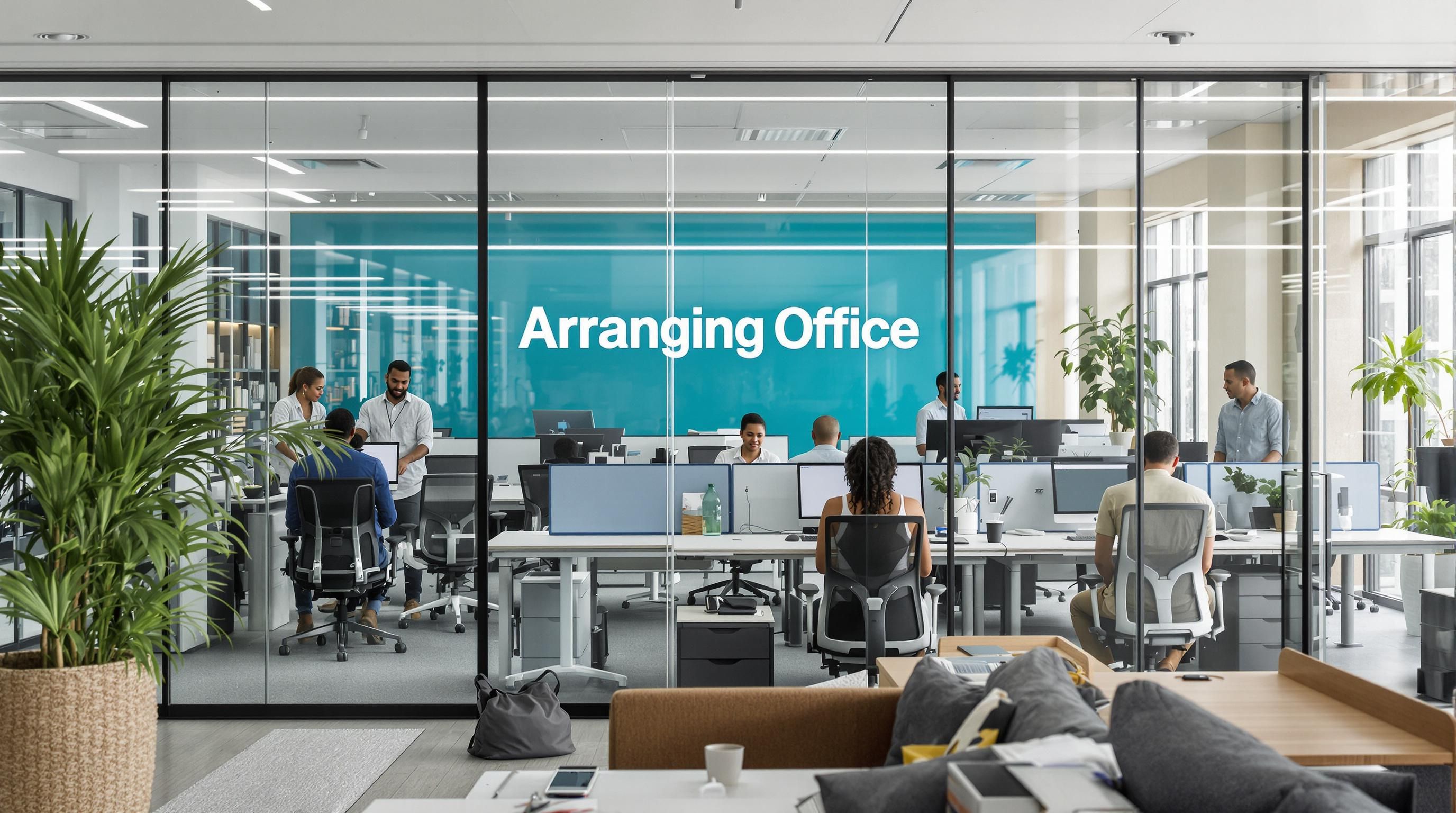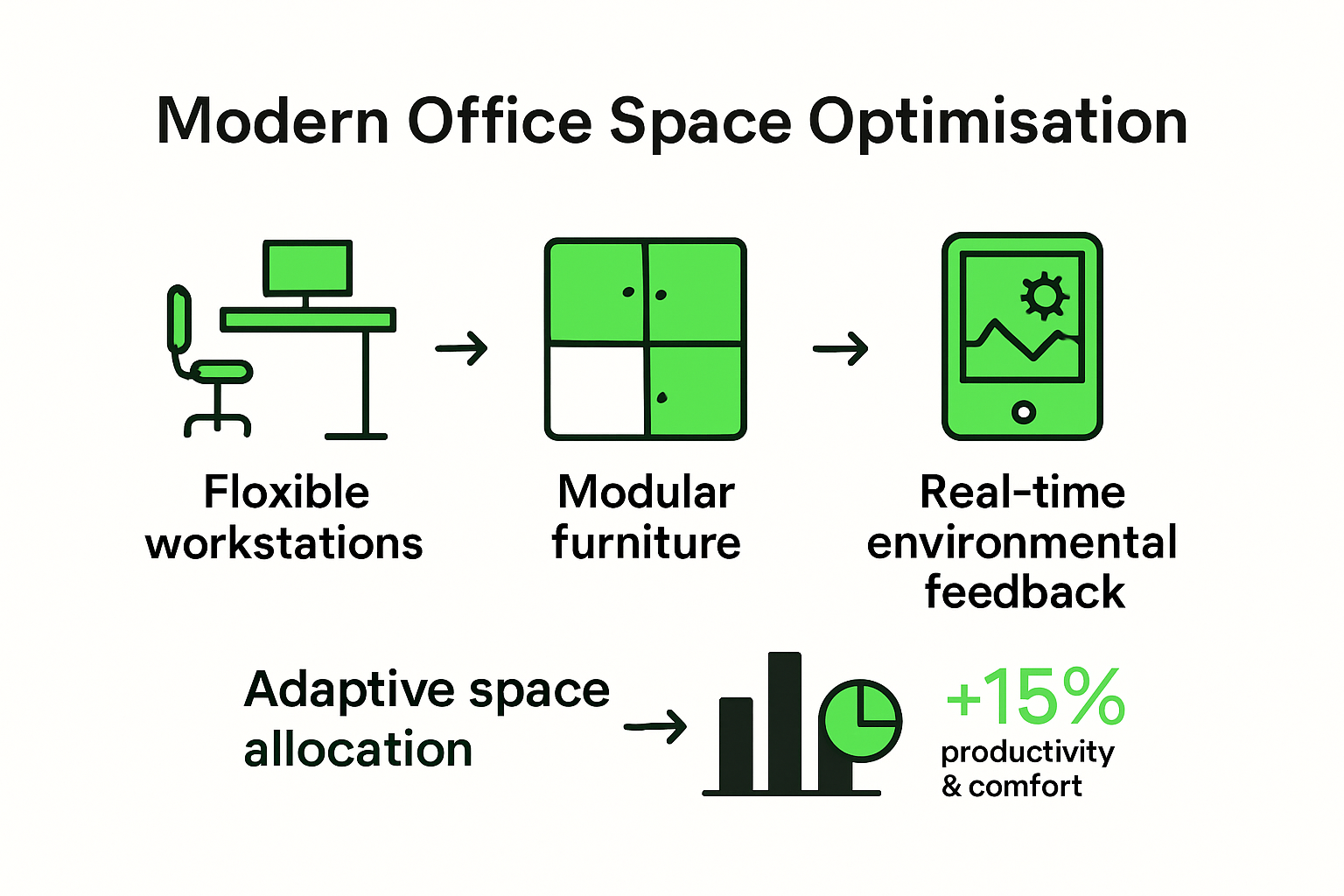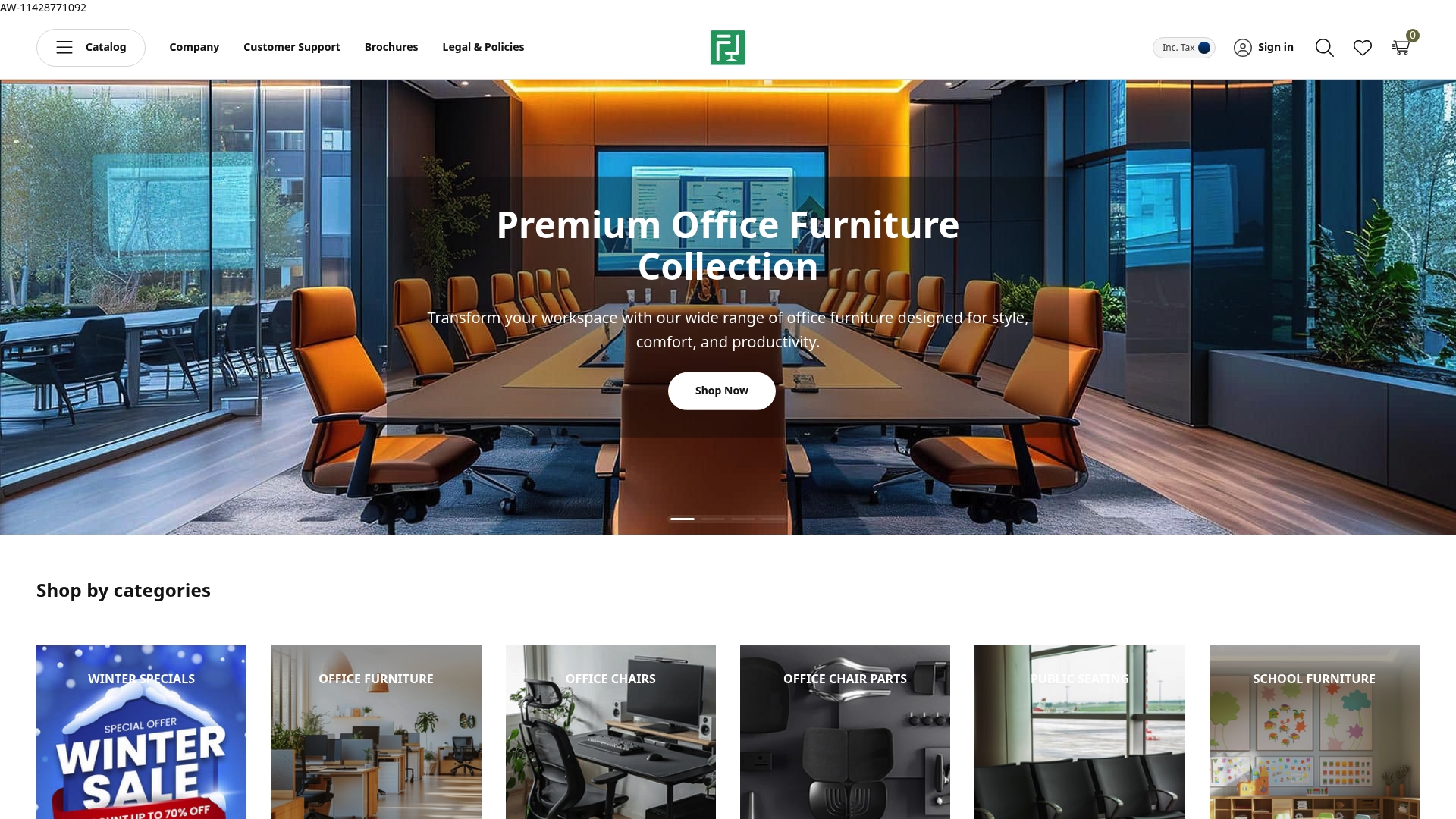Arranging Office Furniture: Practical Tips for South African Businesses 2025
Jul 30, 2025
Arranging Office Furniture: Practical Tips for South African Businesses 2025

Arranging office furniture might seem like a routine task for any business owner. Now think about this. Over 80 percent of workers say workspace layout affects their productivity and happiness. The real surprise? Most companies spend loads on premium desks or fancy chairs but miss out on simple changes that actually boost collaboration and comfort. The most impactful results often come from ordinary tweaks and choices that suit local needs best.
Table of Contents
- Understanding The Basics Of Office Furniture Layout
- Key Considerations For Different South African Workspaces
- Optimising Space For Efficiency And Comfort
- Selecting Accessories To Enhance Your Office Environment
Quick Summary
| Takeaway | Explanation |
|---|---|
| Prioritize ergonomic furniture arrangements | Use adjustable furniture to enhance comfort and accommodate diverse employee needs. |
| Implement strategic space planning | Create functional zones and clear pathways for improved collaboration and productivity. |
| Consider industry-specific requirements | Tailor furniture choices to meet the unique needs of different work environments and industries. |
| Incorporate technology for optimization | Use smart office solutions to track usage and adapt spaces to maximize efficiency. |
| Enhance workspace with thoughtful accessories | Select ergonomic and aesthetic accessories that boost employee morale and comfort. |
Understanding the Basics of Office Furniture Layout
Arranging office furniture is more than simply placing desks and chairs in a room. It involves strategic planning that impacts employee productivity, workplace ergonomics, and overall organizational efficiency. Understanding the fundamental principles of office furniture layout can transform a mundane workspace into an inspiring environment that promotes collaboration, comfort, and professional performance.
Ergonomic Considerations in Workspace Design
Ergonomics plays a critical role in effective office furniture arrangement. According to the Whole Building Design Guide, professional workspace design requires careful attention to accessibility and user comfort. Key ergonomic considerations include maintaining a minimum of 32 inches between furniture and walls to accommodate wheelchair users and ensuring 60 inches of clearance for wheelchair rotation.
Adjustable furniture is paramount in creating an inclusive workspace. Ergonomics4Schools recommends office chairs with adaptable features such as adjustable seat height, backrest height, and tilt mechanisms. Desks should provide ample space for equipment and maintain a standard height of approximately 720mm, ensuring comfortable seating positions for diverse employee needs.
Strategic Space Planning and Flow
Effective office furniture layout goes beyond individual workstation design. It encompasses understanding spatial relationships, traffic flow, and creating functional zones within the workspace. Consider how employees move through the office, ensuring clear pathways that minimize disruptions and facilitate smooth interactions.
Different work styles and organizational cultures demand varied layout approaches. Open-plan designs encourage collaboration and communication, while designated quiet zones provide spaces for focused, individual work. The key is creating a balanced environment that supports multiple work modes and respects employee preferences.
When arranging office furniture, consider modular solutions that offer flexibility. Cluster desks allow teams to configure workspaces dynamically, adapting to changing project requirements and team structures.
Companies must also consider technological integration. Modern office layouts incorporate charging stations, cable management systems, and strategic power outlet placement to support digital workflows. This approach ensures that furniture not only looks aesthetically pleasing but also facilitates seamless technological connectivity.
Remember that office furniture layout is not a one-size-fits-all solution. Each organization has unique needs based on its culture, work processes, and employee preferences. Regular assessment and willingness to adapt the workspace can lead to improved employee satisfaction, productivity, and overall organizational performance.
Key Considerations for Different South African Workspaces
South African businesses represent a diverse landscape of industries, each with unique workspace requirements that demand tailored furniture solutions. From bustling corporate environments in Johannesburg to innovative startups in Cape Town, understanding the nuanced needs of different workspace types is crucial for creating functional and productive work environments.
Corporate and Professional Office Environments
In traditional corporate settings, furniture arrangement must balance professionalism with functionality. The layout should reflect the company’s culture while supporting efficient workflow and communication. Open-plan designs have gained significant popularity, promoting collaboration and transparency. However, these spaces require careful planning to mitigate noise disruptions and maintain individual privacy.
Executive areas demand a different approach. Boardroom furniture should communicate authority and facilitate professional meetings. Boardroom table selections play a critical role in creating an impressive first impression, with design and configuration directly impacting meeting dynamics and perceived organizational sophistication.
Small Business and Startup Workspace Configurations
Small businesses and startups in South Africa often operate with limited space and budget constraints. Flexible, multifunctional furniture becomes essential in these environments. Modular desking systems allow rapid reconfiguration as team sizes fluctuate, providing scalability without significant additional investment.
Ergonomics remain paramount, even in smaller workspaces. Visitor chair selections should balance comfort and professional appearance, ensuring that client-facing areas reflect the organization’s commitment to quality and employee well-being.
Specialized Industry Workspace Considerations
Different industries in South Africa require unique furniture approaches. Manufacturing facilities need robust, industrial-grade furniture that withstands heavy use. Creative industries like design studios prioritize inspirational layouts that encourage innovation. Technology companies often integrate collaborative zones with quiet work areas to support varied work styles.
Regional variations also impact workspace design. Coastal regions might require furniture with corrosion-resistant materials, while inland areas might focus on temperature-adaptive solutions. Understanding these localized nuances ensures that furniture selections are not just aesthetically pleasing but functionally appropriate.
Consider climate and environmental factors when selecting office furniture. South Africa’s diverse climate zones demand materials and designs that can withstand temperature fluctuations, humidity variations, and potential UV exposure. Sustainable and locally manufactured furniture options can provide both environmental responsibility and region-specific durability.
ultimately, successful workspace furniture arrangement transcends mere aesthetic considerations. It represents a strategic investment in employee productivity, organizational culture, and operational efficiency. Businesses that approach furniture selection with a comprehensive, context-aware perspective will create workspaces that not only look professional but actively contribute to organizational success.
Here is a table comparing the furniture arrangement needs of different South African workspace types to help you quickly identify unique considerations.
| Workspace Type | Key Furniture Needs | Special Considerations |
|---|---|---|
| Corporate/Professional | Executive desks, boardroom tables, open-plan workstations | Balance collaboration with privacy, professionalism |
| Small Business/Startup | Modular desks, multi-use furniture, compact visitor chairs | Flexibility, scalability, budget constraints |
| Manufacturing | Industrial-grade tables, durable seating | Robustness, suitability for heavy/long-term use |
| Creative Studios | Collaborative spaces, inspirational layouts | Encourage innovation, aesthetic appeal |
| Technology Firms | Mix of quiet zones and collaborative areas, cable management | Support diverse workstyles, tech integration |
| Coastal Regions | Corrosion-resistant materials | Adapt to humidity, environmental durability |
| Inland Regions | Temperature-adaptive furniture | Adjust for temperature and climate changes |
Optimising Space for Efficiency and Comfort
Creating an optimal workspace involves a delicate balance between efficiency and employee comfort. South African businesses increasingly recognize that workspace design directly impacts productivity, employee satisfaction, and overall organizational performance. The goal is to create an environment that supports diverse work styles while maximizing available space and promoting employee well-being.
Intelligent Space Allocation Strategies
Modern workspace optimization goes beyond traditional layout approaches. Research from the Spacematch study reveals innovative strategies for matching occupants to suitable workspaces. By collecting real-time environmental feedback and integrating IoT sensor data, organizations can create more responsive and adaptive work environments. This approach allows for dynamic space allocation that considers individual preferences and changing workplace needs.
Effective space optimization requires a multifaceted approach. Consider implementing:
- Flexible workstations that can be easily reconfigured
- Modular furniture that adapts to different team configurations
- Versatile meeting areas that support various collaboration styles

Personalizing Environmental Comfort
Comfort is no longer a one-size-fits-all concept. The Comfort-as-a-Service research demonstrates how technology can personalize environmental conditions. By utilizing machine learning and IoT technologies, businesses can create adaptive environments that respond to individual employee preferences. This approach addresses critical comfort factors such as temperature, lighting, and acoustic conditions.
Interesting innovations are emerging in workspace design. A groundbreaking study on adaptive architectural layouts explored the use of mobile robotic partitions in open-plan offices. These autonomous architectural elements can dynamically adjust to address acoustic, visual, and privacy needs, significantly improving worker experience and overall well-being.
Technology-Driven Space Optimization
Technology plays a crucial role in modern workspace design. Smart office solutions enable real-time monitoring and optimization of workspace utilization. Sensors and analytics can track space usage, identifying underutilized areas and providing insights for more efficient layout designs. This data-driven approach allows businesses to:
- Reduce unnecessary space allocation
- Improve overall workspace efficiency
- Create more responsive and adaptable work environments
Consider the unique characteristics of South African workplaces. Climate variations, cultural diversity, and specific industry requirements demand a nuanced approach to space design. Local businesses must balance global best practices with region-specific considerations, creating workspaces that are both internationally competitive and locally relevant.
Ultimately, optimizing workspace is an ongoing process. Regular assessment, employee feedback, and willingness to adapt are key to creating environments that support productivity, creativity, and employee satisfaction. By embracing intelligent design principles and leveraging technological innovations, South African businesses can transform their workspaces into strategic assets that drive organizational success.
Selecting Accessories to Enhance Your Office Environment
Accessories are the unsung heroes of workspace design, transforming ordinary office environments into productive, comfortable, and inspiring spaces. For South African businesses seeking to create dynamic work settings, carefully selected accessories can significantly impact employee performance, comfort, and overall workplace satisfaction.
Ergonomic Support and Comfort Accessories
Ergonomic accessories are crucial for maintaining employee health and productivity. According to the University of North Carolina’s Environment, Health and Safety department, specialized accessories like glare screens and document holders play a critical role in reducing eye strain and promoting proper posture.
Research from Michigan State University emphasizes the importance of investing in ergonomic input devices. Specialized keyboards and mice are designed to minimize physical strain and enhance workplace comfort. For businesses looking to support employee well-being, industrial-grade seating options can provide additional ergonomic support across various work environments.
Key ergonomic accessories include:
- Adjustable monitor stands for optimal screen positioning
- Ergonomic keyboard trays that reduce wrist strain
- Footrests to support proper sitting posture
- Lumbar support cushions for enhanced comfort
Below is a summary table of essential ergonomic and technology accessories mentioned, highlighting their purpose in the workplace.
| Accessory | Purpose/Benefit |
|---|---|
| Adjustable Monitor Stand | Improves screen positioning, reduces neck strain |
| Ergonomic Keyboard Tray | Minimizes wrist strain |
| Footrest | Supports proper seating posture |
| Lumbar Support Cushion | Enhances lower back comfort |
| Wireless Charging Station | Convenient device power management |
| Digital Whiteboard | Facilitates team collaboration |
| Cable Management Solution | Keeps workspaces organized |
| Smart Power Strip | Easy connectivity for multiple devices |
Technology Integration and Workspace Optimization
Accent Interiors highlights the significance of seamlessly integrating technology into office environments. Modern workspace accessories go beyond traditional tools, incorporating smart technologies that enhance productivity and organization.
Consider implementing:
- Wireless charging stations for convenient device power management
- Digital whiteboards to facilitate collaborative work
- Cable management solutions for clean, organized workspaces
- Smart power strips with USB ports for multiple device connectivity
Personalization and Aesthetic Accessories
Workspace accessories are not just functional but also contribute to the overall aesthetic and psychological environment. Personal touches can significantly boost employee morale and create a more inviting workspace. Thoughtful accessories can reflect company culture, promote creativity, and make employees feel more connected to their work environment.
Consider incorporating:
- Plants for improved air quality and psychological well-being
- Art pieces that reflect company values
- Decorative desk organizers
- Mood lighting for adjustable workspace ambiance
For South African businesses, selecting accessories requires consideration of local climate, cultural diversity, and specific industry requirements. The right accessories can transform a standard workspace into a dynamic, efficient, and inspiring environment.
Remember that customer support can provide valuable guidance in selecting the most appropriate accessories for your specific workplace needs. By investing thoughtfully in workspace accessories, businesses can create environments that not only support productivity but also enhance employee satisfaction and well-being.

Frequently Asked Questions
How does office furniture arrangement impact employee productivity?
Proper office furniture arrangement can significantly enhance employee productivity by creating an environment that supports collaboration, minimizes distractions, and ensures ergonomic comfort. A well-planned layout allows for clear pathways and functional zones, promoting efficient workflows.
What are some ergonomic considerations for arranging office furniture?
When arranging office furniture, it’s essential to maintain proper spacing (at least 32 inches between furniture), use adjustable pieces for diverse employee needs, and ensure that all workstations promote good posture to enhance comfort and reduce strain.
What layout styles are recommended for small businesses in South Africa?
Small businesses often benefit from flexible, modular furniture that can adapt to team size and work requirements. It’s important to create multifunctional spaces that maximize limited square footage while ensuring ergonomic comfort and professional appearance.
How can technology be integrated into workspace design?
Integrating technology into workspace design can be achieved by implementing smart office solutions, such as wireless charging stations, digital whiteboards, and effective cable management systems. These tools enhance productivity and maintain organized, efficient work areas.
Upgrade Your Workspace to Boost Team Performance in 2025
Is your current office layout holding your business back? The article has shown how the right furniture arrangement makes a real difference for South African companies. Struggling with productivity drops, cluttered walkways, or uncomfortable workstations? Many offices face these same setbacks. You can transform your space, encourage collaboration and support wellbeing using ergonomic furniture and intelligent planning—exactly what your business needs to stay ahead this year.

Let Office Stock help you unlock your team’s potential. Browse our extensive range of ergonomic office chairs and desks designed for South African conditions, or contact our experts for customised advice. Do not let workspace frustrations impact your staff. Visit Office Stock today to discover solutions tailored for your unique needs and get your office ready for a productive 2025.
Recommended
- Leather In Room Directory Folder | Buy Uncategorized Online - Office Stock
- Hexagonal Boardroom Table | Buy Office Furniture Online - Office Stock
- Zelda High-back Chair | Buy Office Chairs Online - Office Stock
- Double School Desk in Saligna Wood 1000mm Wide | Buy School Furniture Online - Office Stock
